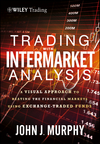|
|

Trading with Intermarket Analysis: A Visual Approach to Beating the Financial Markets Using Exchange-Traded Funds
John J. Murphy
ISBN: 978-1-1183-1437-1
Hardcover
336 pages
November 2012
A visual guide to market trading using intermarket analysis and exchange-traded fundsWith global markets and asset classes growing even more interconnected, intermarket analysis—the analysis of related asset classes or financial markets to determine their strengths and weaknesses—has become an essential part of any trader's due diligence. In Trading with Intermarket Analysis, John J. Murphy, former technical analyst for CNBC, lays out the technical and intermarket tools needed to understand global markets and illustrates how they help traders profit in volatile climates using exchange-traded funds.Armed with a knowledge of how economic forces impact various markets and financial sectors, investors and traders can profit by exploiting opportunities in markets about to rise and avoiding those poised to fall. Trading with Intermarket Analysis provides advice on trend following, chart patterns, moving averages, oscillators, spotting tops and bottoms, using exchange-traded funds, tracking market sectors, and the new world of intermarket relationships, all presented in a highly visual way. - Gives readers a visually rich introduction to the world of intermarket analysis, the ultimate tool for beating the markets
- Provides practical advice on trend following, chart patterns, moving averages, oscillators, spotting tops and bottoms, using exchange-traded funds, tracking market sectors, and intermarket relationships
- Includes appendices on Japanese candlesticks and point-and-figure charting
Comprehensive and easy-to-use, Trading with Intermarket Analysis presents the most important concepts related to using exchange-traded funds to beat the markets in a visually accessible format.
Acknowledgments
Introduction
Part I: The Old Normal
Chapter 1: Intermarket Analysis: The Study of Relationships
Chapter 2: Review of the Old Normal
Chapter 3: The 1997-1998 Asian Currency Crisis
Part II: 2000 and 2007 Tops
Chapter 4: Intermarket Events Surrounding 2000 Top
Chapter 5: The 2002 Falling Dollar Boosts Commodities
Chapter 6: Asset Allocation Rotations Leading To 2007 Top
Chapter 7: Visual Analysis of the 2007 Market Top
Part III: The Business Cycle and ETFs
Chapter 8: Intermarket Analysis and the Business Cycle
Chapter 9: Impact of the Business Cycle on Market Sectors
Chapter 10: Exchange Traded Funds
Part IV: The New Normal
Chapter 11: The Dollar and Commodities Trend in Opposite Directions
Chapter 12: Stocks and Commodities Become Highly Correlated
Chapter 13: Stocks and the Dollar
Chapter 14: The Link between Bonds and Stocks
Chapter 15: The Link between Bonds and Commodities
Conclusion: It’s All about Relationships
About the Author
Index |
|